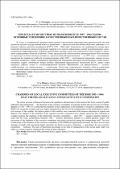| dc.contributor.author | Елизаров, С. А. | |
| dc.coverage.spatial | Барановичи | ru_RU |
| dc.date.accessioned | 2023-11-30T06:53:39Z | |
| dc.date.available | 2023-11-30T06:53:39Z | |
| dc.date.issued | 2022 | |
| dc.identifier.citation | Елизаров, С. А. Председатели местных исполкомов БССР 1953-1964 годов: основные тенденции, качественный и количественный состав / С. А. Елизаров // Вестник Барановичского государственного университета. Сер. Исторические науки и археология. Экономические науки. Юридические науки. – 2022. – № 1. – С. 11–17. | ru_RU |
| dc.identifier.uri | https://elib.gstu.by/handle/220612/29424 | |
| dc.description.abstract | В статье в исторической динамике представлены качественные характеристики руководителей местной вертикали органов государственной власти и управления — председателей исполкомов областных, районных и городских Советов депутатов трудящихся БССР в 1953—1964 годах. Отмечается, что мобильность состава пред седателей исполкомов носила ситуативный характер и во многом определялась линией на реорганизацию адми нистративно-территориального устройства республики: высшие точки этой мобильности были связаны с массо выми сокращениями областей и районов. Смены председателей облисполкомов преимущественно были вызваны
их переходом на более высокую должность, председателей рай/горисполкомов — до 1957 года — негативными
моментами (не справился с работой, скомпрометировал себя), 1958 — позитивными (повышение, перевод на аналогичную должность, учеба). Сменяемость председателей исполкомов проходила исключительно в среде номенклатурных кадров. Значительно возрос уровень образования председателей исполкомов БССР, однако остро
ощущался дефицит людей со специализированным высшим образованием: для райисполкомов — сельскохозяйственным, для горисполкомов — техническим. Отсутствие теоретических знаний в области управления
в исследуемый период в определенной степени нивелировалось обучением в системе партийного просвещения. | ru_RU |
| dc.description.abstract | The article presents in historical dynamics the qualitative characteristics of the heads of the local vertical of public
authorities and management — the chairmen of the executive committees of regional, district and city Soviets of workers' deputies in 1953—1964. It is noted that the mobility of the composition of the chairmen of executive committees in the BSSR was situational in nature and was largely determined by the line for the reorganization of the administrative-territorial structure of the republic: the highest points of this mobility were associated with massive reductions of regions and districts. The changes of the chairmen of the regional executive committees were mainly caused by their transition to a higher position, the chairmen of the district/city executive committees — until 1957 — negative moments (failed to cope with the work, compromised himself), 1958 — positive (promotion, transfer to a similar position, study). The succession of the chairmen of the executive committees took place exclusively among the nomenclature staff. The level of education of the chairmen of the executive committees of the BSSR has significantly increased, but there was an acute shortage of people with specialized higher education: for district executive committees — agricultural, for city executive committees — technical. The lack of theoretical knowledge in the field of management in the period under study was offset to a certain extent by training in the system of party education. | |
| dc.language.iso | ru | ru_RU |
| dc.publisher | БарГУ | ru_RU |
| dc.subject | Белорусская ССР | ru_RU |
| dc.subject | Кадровая политика | ru_RU |
| dc.subject | Советы | ru_RU |
| dc.subject | Исполнительные комитеты | ru_RU |
| dc.subject | Председатели | ru_RU |
| dc.subject | Belorussian SSR | ru_RU |
| dc.subject | Personnel policy | ru_RU |
| dc.subject | Soviets | ru_RU |
| dc.subject | Executive committees | ru_RU |
| dc.subject | Chairmen | ru_RU |
| dc.title | Председатели местных исполкомов БССР 1953-1964 годов: основные тенденции, качественный и количественный состав | ru_RU |
| dc.type | Article | ru_RU |
| dc.identifier.udc | 94(476)«1953–1964» | |
